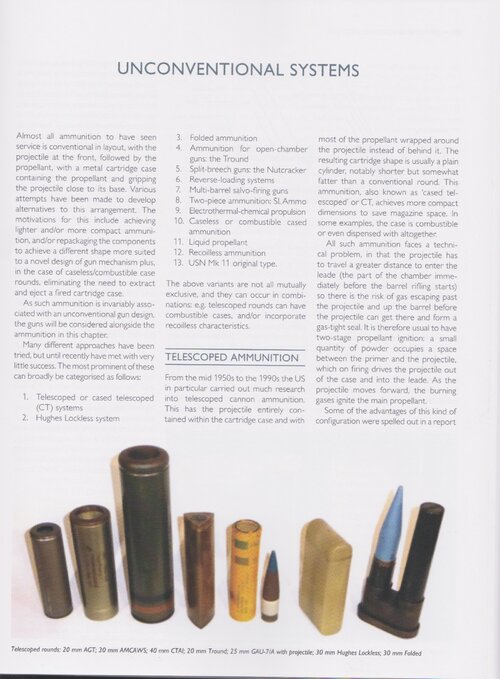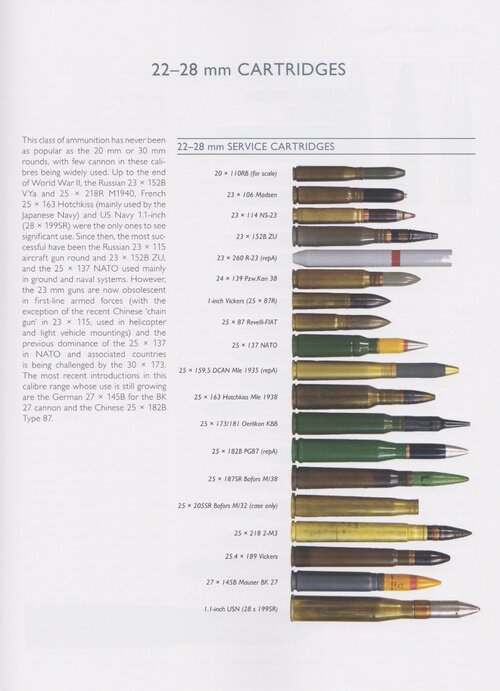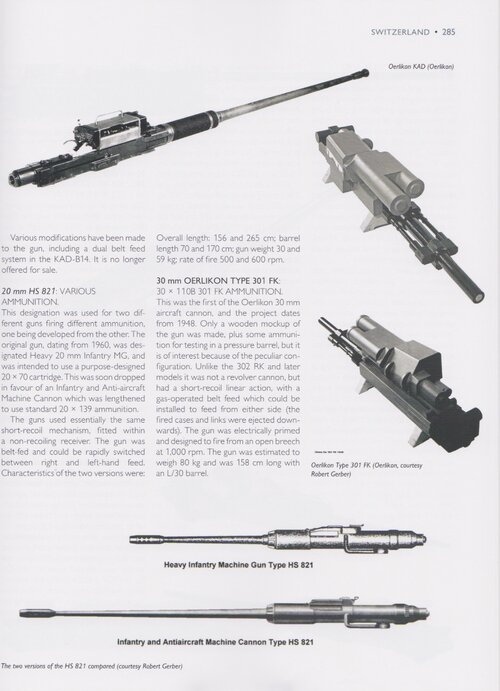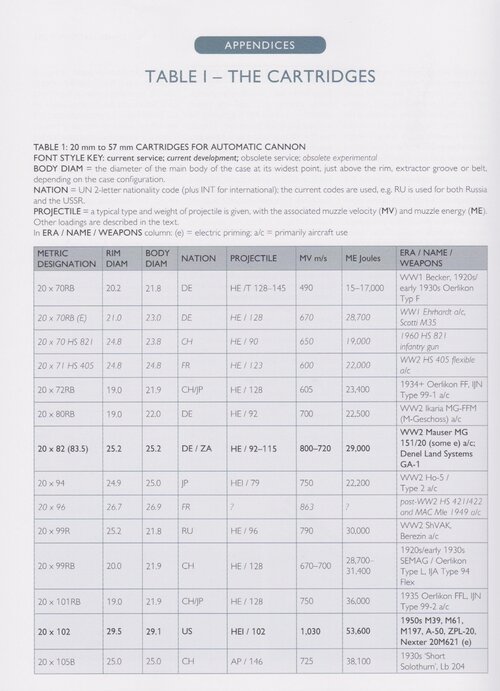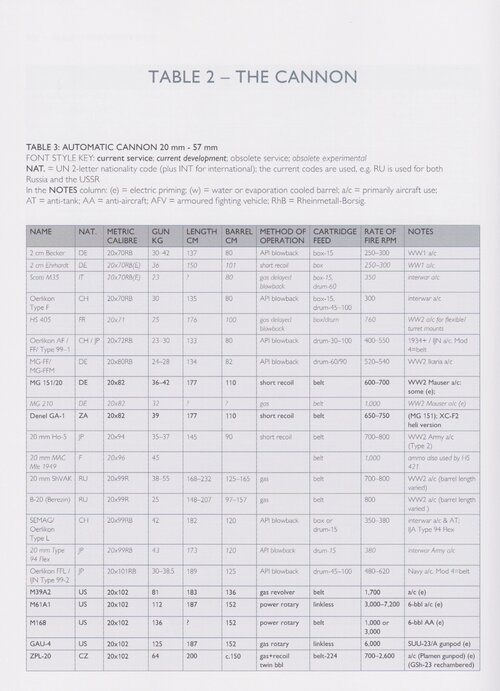- Joined
- 27 December 2005
- Messages
- 16,722
- Reaction score
- 20,509
Hi everyone.
I was sent a review copy of Anthony (Tony) Williams' latest book, published by Crowood Press.
A forum member, Tony has previously written Rapid Fire - The Development of Automatic Cannon, Heavy Machine Guns and their Ammunition (Airlife, 2000), then expanded on the airborne sections of that book with "Flying Guns of World War 2" (Crowood, 2003) and "Flying Guns of the Modern Era" (2008).
With Maxim Popenker he co-wrote Machine Gun: The Development of the Machine Gun from the Nineteenth Century to the Present Day (Crowood, 2008) and Sub-Machine Gun: The Development of Sub-Machine Guns and their Ammunition from World War 1 to the Present Day (Crowood, 2012)
Autocannon - A History of Automatic Cannon and their Ammunition appears to be the successor to the autocannon coverage of Rapid Fire, as the Machine Gun parts were superceded previously with the works with Maxim Popenker. It is the culmination of Tony's many years of research in the subject.


Autocannon - A History of Automatic cannon and their ammunition is 384 pages in length with over 500 illustrations. In my review copy there was no cover art, but I've posted pictures from the internet.
The book is structured into four parts.
The first part is a history of the development and uses of automatic cannon in land, sea and air from the 19th century to the present day.
The second part looks at the design of both cannons and their cartridge ammunition, the various types of projectiles and the technical factors affecting them, including some unconventional types.
The third section is an extensive compilation of information about cartridges from all around the world, including experimental ones, by country, and then roughly in order of the date of introduction.
The fourth section is the same, but this time listing automatic cannons. Each country section has an introduction about the companies, designations, then descriptions of the various autocannon roughly in date order.
At the end of the book are tables of all the cartridges and autocannon mentioned in the book with their basic characteristics, a glossary, sources and a useful index.
So the question is, what did I think of it?
I'm far from an expert in guns, but overall I found this an interesting book. My favourite section was the second part, which goes into detail on the technologies and design of autocannon and their ammunition. I found this section quite illuminating on a subject I have only a passing familiarity with, enjoyable and easy to read. The first section, an overview of the history of the autocannon, was my next favourite part. It's well written, and gives a good summary of the major developments in autocannon design and technology in each historical era to the present day.
The comprehensive sections on cartridges and cannons of the world will be useful for a reference work in future, but for a casual reader, something to dip in and out of I think.
The book concentrates squarely on the guns and ammunition, not really going into the design of the mounts or fire control. This was intentional on the part of the author, and was necessary for brevity given the scope of the book.
Something I found quite unique about this book was that it places as equal an emphasis on the cartridges as on the cannons. It was not surprising to learn that Tony Williams is editor of Jane’s Weapons: Ammunition, and it makes sense - a gun without ammunition is a purposeless metal tube. It is clear that Tony has a lot of knowledge in this area.
The illustrations (in my PDF review copy at least) were a little variable in quality - this at times may reflect limitations of the original source materials, while cannon and especially cartridges are not especially photogenic subjects to my mind. In this respect I think Airlife did a better job with Rapid Fire.
Most illustrations in Autocannon are photos, and any diagrams appear to be taken from other sources. I think it would have been nice to have some diagrams specifically drawn for the book, particularly for the second part, where at times it would help me better visualize the various technologies being discussed. Rapid Fire had a nice set of comparative scale drawings of cartridges for example.
These are however minor quibbles. If you are looking for a book about automatic cannon, it would be hard to imagine a better option. It is only partly "a history", it is also a comprehensive reference work for those of us who can't afford Janes' titles.
I was sent a review copy of Anthony (Tony) Williams' latest book, published by Crowood Press.
A forum member, Tony has previously written Rapid Fire - The Development of Automatic Cannon, Heavy Machine Guns and their Ammunition (Airlife, 2000), then expanded on the airborne sections of that book with "Flying Guns of World War 2" (Crowood, 2003) and "Flying Guns of the Modern Era" (2008).
With Maxim Popenker he co-wrote Machine Gun: The Development of the Machine Gun from the Nineteenth Century to the Present Day (Crowood, 2008) and Sub-Machine Gun: The Development of Sub-Machine Guns and their Ammunition from World War 1 to the Present Day (Crowood, 2012)
Autocannon - A History of Automatic Cannon and their Ammunition appears to be the successor to the autocannon coverage of Rapid Fire, as the Machine Gun parts were superceded previously with the works with Maxim Popenker. It is the culmination of Tony's many years of research in the subject.
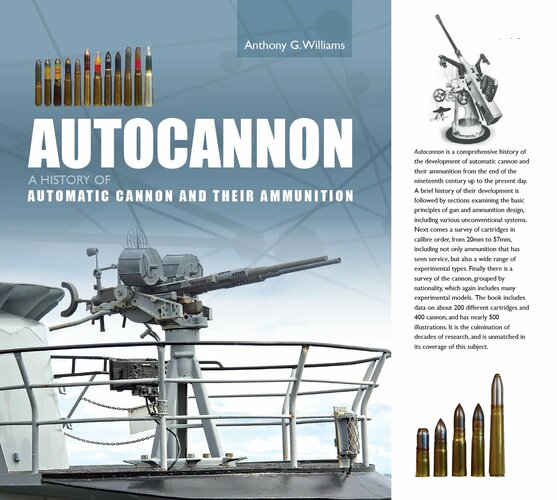
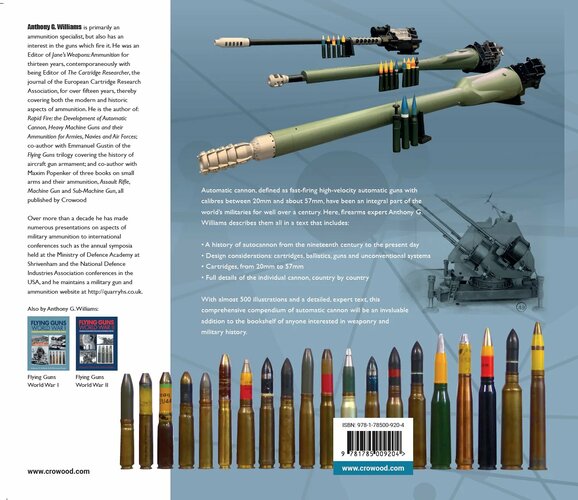
Autocannon - A History of Automatic cannon and their ammunition is 384 pages in length with over 500 illustrations. In my review copy there was no cover art, but I've posted pictures from the internet.
The book is structured into four parts.
The first part is a history of the development and uses of automatic cannon in land, sea and air from the 19th century to the present day.
The second part looks at the design of both cannons and their cartridge ammunition, the various types of projectiles and the technical factors affecting them, including some unconventional types.
The third section is an extensive compilation of information about cartridges from all around the world, including experimental ones, by country, and then roughly in order of the date of introduction.
The fourth section is the same, but this time listing automatic cannons. Each country section has an introduction about the companies, designations, then descriptions of the various autocannon roughly in date order.
At the end of the book are tables of all the cartridges and autocannon mentioned in the book with their basic characteristics, a glossary, sources and a useful index.
So the question is, what did I think of it?
I'm far from an expert in guns, but overall I found this an interesting book. My favourite section was the second part, which goes into detail on the technologies and design of autocannon and their ammunition. I found this section quite illuminating on a subject I have only a passing familiarity with, enjoyable and easy to read. The first section, an overview of the history of the autocannon, was my next favourite part. It's well written, and gives a good summary of the major developments in autocannon design and technology in each historical era to the present day.
The comprehensive sections on cartridges and cannons of the world will be useful for a reference work in future, but for a casual reader, something to dip in and out of I think.
The book concentrates squarely on the guns and ammunition, not really going into the design of the mounts or fire control. This was intentional on the part of the author, and was necessary for brevity given the scope of the book.
Something I found quite unique about this book was that it places as equal an emphasis on the cartridges as on the cannons. It was not surprising to learn that Tony Williams is editor of Jane’s Weapons: Ammunition, and it makes sense - a gun without ammunition is a purposeless metal tube. It is clear that Tony has a lot of knowledge in this area.
The illustrations (in my PDF review copy at least) were a little variable in quality - this at times may reflect limitations of the original source materials, while cannon and especially cartridges are not especially photogenic subjects to my mind. In this respect I think Airlife did a better job with Rapid Fire.
Most illustrations in Autocannon are photos, and any diagrams appear to be taken from other sources. I think it would have been nice to have some diagrams specifically drawn for the book, particularly for the second part, where at times it would help me better visualize the various technologies being discussed. Rapid Fire had a nice set of comparative scale drawings of cartridges for example.
These are however minor quibbles. If you are looking for a book about automatic cannon, it would be hard to imagine a better option. It is only partly "a history", it is also a comprehensive reference work for those of us who can't afford Janes' titles.
Last edited:

